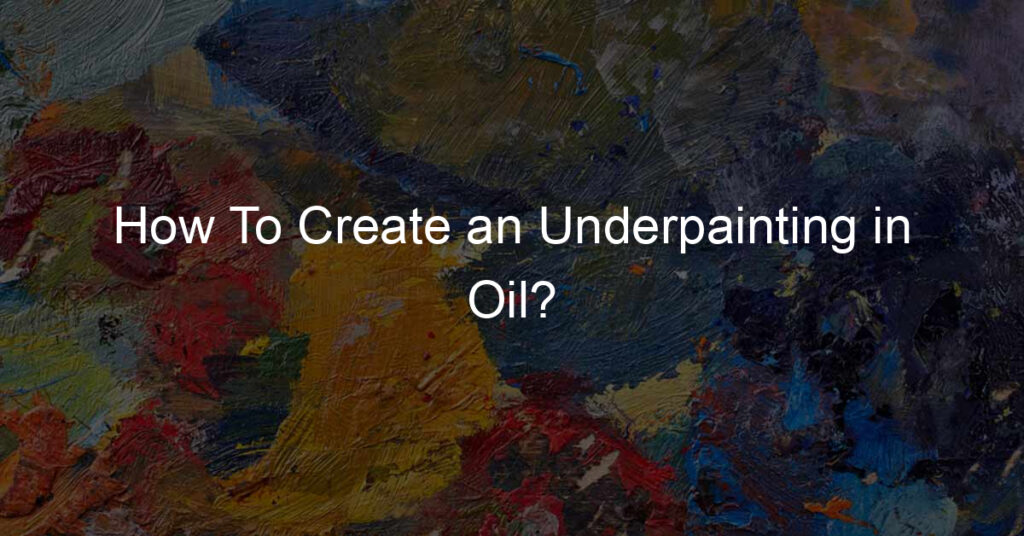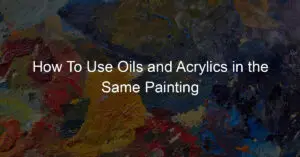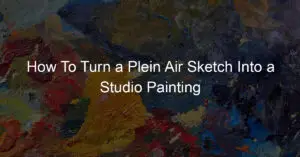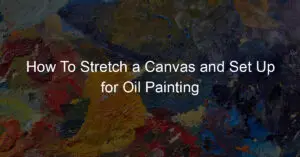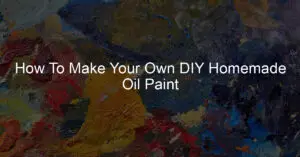Underpainting is an important step in creating an oil painting. It allows the artist to block out their composition, values, and colors while they focus on refining details later.
Here are some steps to create a successful underpainting:
1. Choose support for your painting: The most common supports are canvas or wood panels. Try to make sure that your surface is clean and free of any dirt or dust before you begin.
2. Draw your composition onto the surface: Before beginning with paint, it is best to draw out your composition first so you have a reference point when applying paint layers.
This way you can plan out color transitions, line work, value changes, etc accordingly.
3. Prime the surface: After your drawing is complete, prime the surface with a gesso or an oil primer.
This will help protect any underlying layers from becoming damaged and give the painting a uniform base for further layers of paint.
4. Begin laying in basic shapes and values: Start by creating simple shapes of light and dark color to block out your composition.
Using thin washes of transparent paint, begin mapping out what will be your darks, lights, and mid tones in your painting.
Try to keep this layer as thin as possible without losing quality — this allows you to make changes easily later on if needed.
5. Experiment with color: Once you’re happy with the value structure of your underpainting, begin experimenting with color.
Start by layering in thin washes of transparent paint to define the shapes and values better. This will give you a better idea of how your painting will look when it’s finished.
6. Refine the details: As you refine the details of your painting, use glazing techniques to add more layers and transparency to your work without losing any previous layers.
When you’re happy with your underpainting, let it dry overnight before moving on to the next stages of oil painting.
By following these steps, you can create an effective underpainting that will be a great foundation for an oil painting!
Remember to take time and plan out each step so that your result is as successful and beautiful as possible.
What Oil Do You Use for Underpainting?
The best type of oil to use for underpainting is a slow-drying, low-viscosity paint such as Linseed or Walnut Oil.
These oils will give you more time to work out your composition and details without the paint drying too quickly.
If you need to speed up the drying time, you can mix in small amounts of stand oil or alkyd mediums into your paints.
These mediums are derived from plant oils and will help keep your painting liquid while it dries faster than pure linseed or walnut oil would.
Additionally, if working on a large-scale painting, you may want to consider using Liquin, which is an alkyd-based medium that speeds up the drying process even further
Do You Let Oil Paint Dry Between Layers?
When painting an underpainting, it’s a good idea to let your paint dry between layers.
This will give you more control over your paint and prevent the different layers from mixing.
Paint will also create a more transparent finish if you allow it to dry for a few hours before applying the next layer.
If you don’t let your paint dry, it can cause blotches or streaks on the canvas, which can ruin the overall presentation of your work.
How Do I Make Underpainting?
The best way to make an underpainting is to start with a light layer of thinned paint.
You can use a brush, knife, or even your fingers to apply the paint in a thin coat that will dry quickly.
After the first layer has dried, you can add thicker paint layers and blend the colors until you have created the desired effect.
When painting with oil paints, you should allow each layer to dry completely before adding another one — this will help ensure that no layers mix and create an uneven surface.
Finally, be sure to keep your painting ventilated while it’s drying so that the fumes don’t build up too much and damage your work!
Is Raw Umber Good for an Underpainting?
Using raw umber is an excellent option for underpainting, specifically because it’s quite dense.
It also tends to be opaque, so you don’t have to worry about mixing the paint too much before applying it to your canvas.
Raw umber also creates a nice warm color that can give depth and dimension to any still-life painting.
This is especially important when you’re painting a portrait in oil. Another perk of using raw umber is that it dries relatively quickly, which will help you with your dry-brush technique.
What Is the Best Color for an Underpainting?
When deciding on the color for your underpainting, you want to make sure that you choose a color that is complementary to your main painting.
For example, if your final painting is going to be brown and green, it’s best to paint a light yellow underpainting that will help ground the scene.
This will help create contrast between the colors and make your painting appear more vibrant.
Conclusion
Creating effective underpainting for your oil painting is a great way to ensure success before you even begin.
Take the time to plan out each step and use slow-drying oils, such as linseed or walnut oil, to create the best canvas possible.
Finally, allow your paint to dry between layers so that the colors stay separate and vibrant.
By following these simple steps, you’ll be sure to create a beautiful painting with impressive underpainting!

